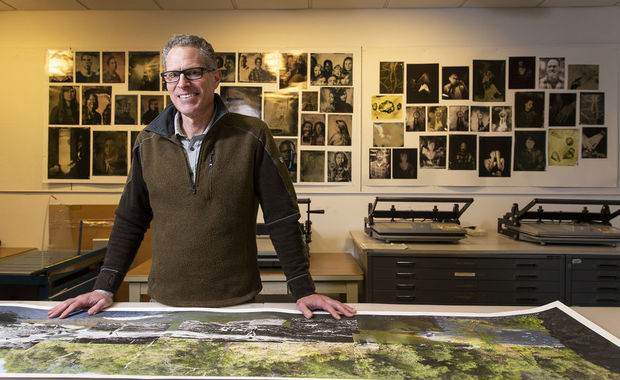On the Block: 5 Questions for Byron Wolfe

Professor Byron Wolfe is an accomplished photographer whose work is widely published and exhibited, a Guggenheim Fellow, and the current chair of the Art Department at the Tyler School of Art and Architecture.
He is passionate about collaborative research projects that investigate topics that span the visual arts, humanities and natural sciences, and uses photography and other visualization tools to tell stories that reflect upon broader notions of culture and the constructions of landscape, perception and time.
Wolfe participated in the 2021 documentary, Exposing Muybridge, about the pioneering 19th century photographer Eadweard Muybridge. The 88-minute film will be shown on Thursday, October 24 at 4:30 p.m. at the Rainey Auditorium Penn Museum, followed by a Q&A with Wolfe and the film's director. He shares some thoughts on the subject.
What was your role in the new Muybridge documentary?
My role was as an expert and interviewee on Muybridge, especially for his landscape photographs in Yosemite and Central America. I also narrate a few brief passages (recorded on an iPhone during the height of the pandemic). A collaborator and I were also “characters” in the film as we were asked to revisit a photographic project we’d done in Yosemite. We are depicted romping around Yosemite, talking about photography and Muybridge which, although a re-enactment, was a pretty accurate representation of what we actually do when we’re in the field.
How did you become interested in Muybridge? How did you get involved in the project?
I was initially contacted by the director, Marc Shaeffer, because some collaborators and I (the photographer Mark Klett and the writer Rebecca Solnit) had done a lot of work with Muybridge’s 1872 photographs of Yosemite, which are strange and arresting photographs. We used his pictures, among others from that era, as a starting point to reconsider the iconic status of Yosemite in America’s conception of wilderness. We also examined how the place was interpreted by early Euro-Americans, how our conceptions of landscape have developed and been shaped by photography, and we investigated how the landscape has changed—or not—over time. (Yosemite in Time, Trinity University Press, 2005).
When he (Shaeffer) first contacted me, I was just finishing another book with cultural geographer Scott Brady that used 1875-76 Muybridge pictures from an extended photography project in Central America (Phantom Skies, Temple University Press and Radius Books, 2017, with Scott Brady). Those pictures were complex combination prints where he made new imagery from selected portions of different negatives. He added clouds to skies, mostly, but in one case, added extra volcanoes to a scene! One of the chapters from that book describes my experience of tracking down Muybridge’s headstone in England. That story was used in a scene in the film in which it is loosely depicted by the actor Gary Oldman (a Muybridge fan).

What can Muybridge's significance and practices in the 19th century teach students today?
Muybridge’s landscape photographs are instructive in that they’re great ways to begin to understand how photographs have always been constructions of one kind or another. We tend to think that image manipulation began with the advent of Photoshop and other digital tools, but from its earliest origins, image construction – either in front of the lens or after the fact in a darkened room – are woven into the fabric of the medium.
Muybridge’s most well-known pictures are from a massive photographic project that took place at Penn, where he made tens of thousands of “Animal Locomotion” pictures that depict people and animals engaged in all kinds of activities and they unfold over time. He’s credited with being one of the people who helped lay the foundation for films (his work was referenced in the recent Jordan Peele film, NOPE.)
For the past few years, I’ve been working on another project that looks at some artifacts from that massive project. I argue that work from the Animal Locomotion series is the very first large photographic data set, and that many aspects from that effort share haunting similarities to AI-generated imagery where images have an appearance of reality, but are constructions, derived from complex and mostly invisible processes that we don’t fully understand.
What do you hope viewers take away from the film?
That Muybridge was a colorful and tragic historical figure, desperate to be a character in his own story. He was also wildly ambitious, inventive, and obsessive, which can be seen through his photographs. But he also had some pretty severe human flaws (including the murder of his wife’s companion). Ultimately, his photographs are instructive in seeing how images are stories and realities are constructed for both influence and consumption.
What surprised you most during your research and projects about Muybridge?
One of the things I’ve learned about Muybridge and his photographs is that there’s always a new discovery to be made; he is like a magician who always has a trick hiding up his sleeve -- if you look closely enough, you’re sure to uncover another secret.
On the Block is a new occasional series of snapshots about the people of Tyler.